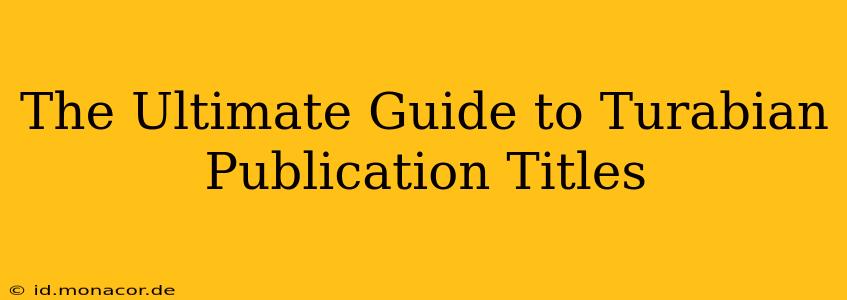The Turabian style, a widely used citation format, particularly in the humanities, requires precision in citing sources. Understanding how to correctly format publication titles is crucial for maintaining academic integrity and avoiding plagiarism. This guide delves into the intricacies of formatting titles within the Turabian system, addressing common questions and offering clear examples. Whether you're a seasoned researcher or just beginning your academic journey, this comprehensive guide will ensure your citations are accurate and consistent.
What is the Turabian Style?
Before diving into title formatting, let's briefly clarify what Turabian is. Developed by Kate L. Turabian, A Manual for Writers of Term Papers, Theses, and Dissertations provides a comprehensive guide for academic writing and citation. It's closely related to the Chicago Manual of Style, offering a slightly simplified approach, often preferred by students and researchers in the humanities. The style emphasizes clarity, consistency, and proper attribution of sources.
How to Format Titles in Turabian: The Basics
Turabian employs distinct formatting rules for different types of publications. Generally, titles are italicized or placed in quotation marks depending on the type of work.
-
Books: Titles of books are always italicized. For example: The Great Gatsby by F. Scott Fitzgerald.
-
Articles/Chapters in Books/Journals: Titles of articles, chapters within books, and journal articles are enclosed in quotation marks. For example: "The Roaring Twenties: A Re-evaluation" in American History Quarterly.
-
Journals/Magazines: Titles of journals and magazines are italicized. For example: The New Yorker.
-
Websites/Online Publications: The title of a website is generally italicized, while the title of a specific article or page on that website is enclosed in quotation marks. For example, the website The New York Times contains the article, "The Impact of Social Media."
-
Reports/Government Documents: Titles of reports and government documents are usually italicized.
Commonly Asked Questions about Turabian Publication Titles
1. What if a title contains a subtitle? How do I format that?
Both the main title and the subtitle should follow the italicization/quotation mark rules based on the type of publication. Use a colon to separate the main title from the subtitle. For example:
- Book: The Structure of Scientific Revolutions: A Classic Work in the Philosophy of Science.
- Article: "The Impact of Climate Change on Coastal Communities: A Case Study of Bangladesh"
2. How do I handle titles within titles?
When a title appears within another title (e.g., an article title within a book chapter title), use italics for the larger work and quotation marks for the smaller, contained title.
For Example: In the book Understanding the American Dream, there is an essay titled, "The American Dream in Literature."
3. How do I format titles in different languages?
Generally, you should italicize or place in quotation marks based on the rules above, regardless of the language. However, always ensure consistency throughout your work.
4. What about translated titles?
When citing a translated work, list the original language title in italics followed by a translation in parentheses. For example: Don Quixote de la Mancha (Don Quixote).
5. Are there any exceptions to these rules?
While these guidelines cover most scenarios, there might be rare exceptions. Always refer to the most recent edition of A Manual for Writers of Term Papers, Theses, and Dissertations for comprehensive guidance.
Mastering Turabian: Beyond Titles
This guide provides a foundation for correctly formatting publication titles within the Turabian style. Accurate citation is vital for academic integrity, and understanding these rules is a significant step towards mastering the Turabian style. Remember to consult the official manual for comprehensive coverage and the latest updates on style conventions. Consistent application of these rules ensures clarity and professionalism in your academic writing.

